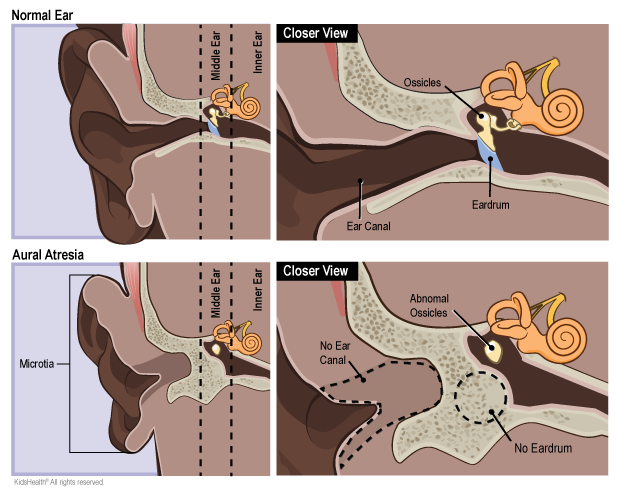Aural Atresia
What Is Aural Atresia?
Aural atresia is when a baby is born without an ear canal. The baby's eardrum either didn't form normally or is missing. There also are problems with the middle ear bones (called ossicles). The parts of the inner ear, including the auditory (hearing) nerve, are usually normal. Most babies with aural atresia also have microtia (a small, misshapen outside part of the ear).
Aural atresia (OR-ul eh-TREE-zhuh) causes hearing loss, but treatments can help most children hear better.
What Are the Signs & Symptoms of Aural Atresia?
Aural atresia can happen in one or both ears, but most commonly affects only one ear. If it happens in one ear only, the hearing in the other ear usually is normal.
Because the canal did not form at all, there is no opening of the ear. Children with aural atresia may also have:
- trapped skin in the small ear canal called a cholesteatoma
- slowed speech and language development
What Causes Aural Atresia?
Doctors don't know exactly why aural atresia happens. It is sometimes caused by genetic changes (mutations).
Some children with the condition also have a genetic syndrome such as Treacher Collins syndrome or Goldenhar syndrome.
How Is Aural Atresia Diagnosed?
If a baby has problems with how their outer ear formed or fails a newborn hearing screen, doctors will check for other problems by doing an exam and more hearing tests.
Imaging studies, such as a CT scan, usually aren't done until children are closer to 6 years old. That's because the temporal bone around the ear grows a lot early in life.

How Is Aural Atresia Treated?
Babies with aural atresia need a care team to help them get the best treatment. They include:
- an otolaryngologist (ear, nose, and throat doctor) to help plan treatment and do surgery
- an audiologist (hearing specialist) to help treat hearing loss
- a speech therapist to help with talking and understanding language
- a pediatric plastic surgeon to rebuild the ear (if the child has microtia)
- a pediatrician to help coordinate care and treat any ear infections right away
- a geneticist to help families understand how aural atresia can run in families
Not every child with aural atresia will get surgery. It depends on how the middle and inner ear are formed and how the temporal bone grows over the first few years of life. A hearing device can help improve hearing for almost all kids with the condition.
How Do Doctors Treat Hearing Loss in Aural Atresia?
It’s important for a baby’s development to treat any hearing loss as soon as possible. Most children with aural atresia have a normal hearing nerve, so they can use a bone conduction device. This device bypasses the missing ear canal and takes sound vibrations directly to the hearing nerve.
On babies, the device usually is attached with an elastic band that goes around the child’s head. As kids grow, other hearing devices can help. Some can be surgically placed in the bone behind the ear or inside the ear.
What Else Should I Know?
If your child has aural atresia, there are many treatments that can help. Hearing devices to improve hearing, surgery to fix the way the outer ear looks, and speech therapy are all available. Talk to your doctor about which treatments are best for your child.
If your child has other medical problems, be sure to follow the doctor’s instructions for care.
As kids get older, they might worry about their condition or the way their ear looks. They may want to talk to a social worker or counselor.
Talking with other parents whose children have aural atresia can help. You also can find more information, support, and resources online at:
Reviewed by: William J. Parkes, IV, MD
Date Reviewed: May 20, 2022
















